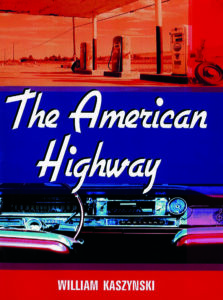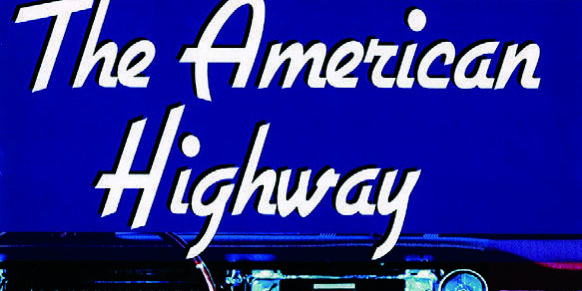The American Highway: The History and Culture of Roads
in the United States
By William Kaszynski
Jeferson, NC: McFarland & Company, 2000
Softcover, 237 pages
Reviewed by Ralph S. Wilcox
 In my work writing nominations to place properties on the National Register of Historic Places, I peruse many books on American roads and roadside architecture. However, I was unfamiliar with William Kaszynski’s The American Highway: The History and Culture of Roads in the United States. The book provides readers with a scenic ride along American roads, including side trips exploring roadside establishments. My initial glance through the publication, which is liberally illustrated with historical photographs, only whetted my appetite. I couldn’t wait to depart on a vicarious trip.
In my work writing nominations to place properties on the National Register of Historic Places, I peruse many books on American roads and roadside architecture. However, I was unfamiliar with William Kaszynski’s The American Highway: The History and Culture of Roads in the United States. The book provides readers with a scenic ride along American roads, including side trips exploring roadside establishments. My initial glance through the publication, which is liberally illustrated with historical photographs, only whetted my appetite. I couldn’t wait to depart on a vicarious trip.
Kaszynski’s book is 237 pages and is divided into six chapters. The book’s first chapter, “A Brief History of Roads,” takes the reader on a whirlwind ride through the development of roads from the Assyrians through the end of the 19th century. The other chapters cover mainly 20-30-year periods of history, including “The Early Days (1900-1919),” “The First Generation (1920-1945),” “The Golden Age (1946-1969),” “The Interstate Era (1970-2000),” and “The Future.” Although the 2000 publication date of the book is apparent in reading the last chapter—some things discussed have already occurred—the other chapters are still very relevant.
One striking fact that Kaszynski conveys in the first chapter is that parts of the Appian Way in Italy still used today utilize the original pavement dating from more than 2,000 years ago. In contrast, “The oldest highway in America dates to 1673 when a post rider delivered mail from New York City to Boston.” And to think that I was excited when I was able to nominate a highway segment to the National Register that retains its original concrete pavement from the 1920s!
Concerning Kaszynski’s chapter “The Future,” it is interesting to look back on the chapter 20 years later and see what has come true and what has not. For example, in discussing automobile safety, he notes, “After requiring that all new cars include air safety bags, we’ll add side-mounted airbags, then safer airbags, etc.”
Kaszynski also touches on the U.S. Department of Transportation (DOT)and Federal Highway Administration FHA)’s ISTEA and TEA-21 programs, and it is interesting to see that one of the goals of ISTEA was “To develop an ‘Automated Highway System” (AHS), including “smart vehicles” equipped with crash-avoidance technology.” Although I don’t know how much of the AHS has come true, many vehicles today have crash-avoidance technology in the form of flashing lights, alarms, and automatic braking.
Kaszynski also talks about the “Intelligent Transportation System” (ITS), which encompassed many radical features that have become commonplace today. For example, he writes that “Delco Electronics demonstrated a concept car in 1996 equipped with two dozen security, safety, and communication features. When safety airbags are deployed in a front-end collision, the vehicle automatically sends a message to emergency services for assistance.” Also, he notes that “Microsoft and Intel have developed computer software called ‘Connected Car-PC” and “Auto-PC with some radical new features. The new software package enables driver and vehicle to become a mobile office-communication center, with traffic and weather information, e-mail, a fax/pager, and cellular telephone…Computer technology is making the possibilities in future transportation almost limitless.”
Kaszynski covers a lot of ground in his book, but he does it in a readable style for the layperson. There’s something for every commercial archeologist, from hotels and gas stations to restaurants and Greyhound bus lines. Throughout the book, Kaszynski provides rest stops at restaurants such as Howard Johnson’s, McDonald’s, and Dairy Queen, as well as hotels and motels, including Holiday Inn, Ramada, and Motel 6. Gas stations are added detours, including Chevron, Phillips Petroleum, Mobil, and Shell, along with other popular brands of the 20th century.
A thorough index and notes accompany the text. The historical photographs are from various sources, including the National Archives, AAA, the U.S. DOT/FHA, and the Pennsylvania Turnpike Commission. The author has also accessed the photo archives of several companies he profiles, such as Stuckey’s, Kentucky Fried Chicken, and Chevron. Kaszynski’s impressive photographs supplement these images. The images alone make the book a valuable resource for those studying the American roadside, and a few maps, diagrams, and charts round out the book’s illustrations.
Given the number of National Register nominations that I have written for highway segments, gas stations, bridges, and other roadside properties, I was surprised that I was previously unfamiliar with The American Highway. However, it’s a book that will remain within easy reach on my office bookshelf. Kaszynski’s book is a must-have for your library for anyone interested in the history of American roads or its businesses.
Ralph S. Wilcox is the National Register and Survey Coordinator for the Arkansas Historic Preservation Program and a previous SCA’s Board of Directors member.
This book review originally appeared in the SCA Journal, Fall 2021, Vol. 40, No. 2. The SCA Journal is a semi-annual publication and a member benefit of the Society for Commercial Archeology.
More Book Reviews


